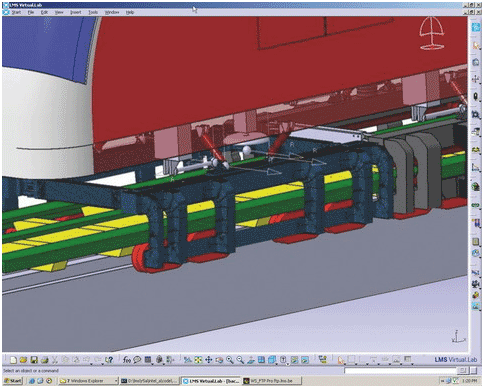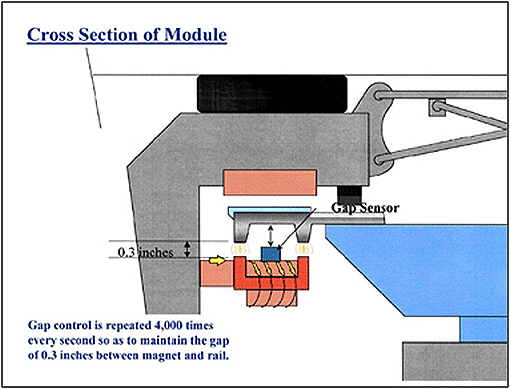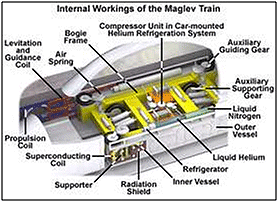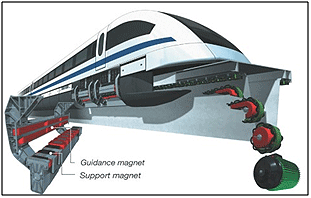Why Current Maglev is not viable
Traditional maglev trains use a series of magnets to lift and propel passengers to speeds in excess of 300 MPH with no physical contact to the supporting guideway. Generally current maglev train systems utilize electromagnets fitted on either the underside/side/top or both of specially designed guideways and lift and propel the train that is wrapped around the guide-way. In the Japanese system, superconducting magnets on the vehicles and embedded windings in a u-shaped guideway are used to repel and propel a vehicle lying within the guideway itself.
with no physical contact to the supporting guideway. Generally current maglev train systems utilize electromagnets fitted on either the underside/side/top or both of specially designed guideways and lift and propel the train that is wrapped around the guide-way. In the Japanese system, superconducting magnets on the vehicles and embedded windings in a u-shaped guideway are used to repel and propel a vehicle lying within the guideway itself.
While maglev prototypes and commercially operated maglev systems have demonstrated drastically reduced operating costs and carbon emissions, incompatibilities with existing rail infrastructure and $50-200 million per mile construction costs have become insurmountable impediments to mainstream adoption. The high cost of maglev systems results from the need for a stand-alone guideway construction featuring active magnetic coils embedded directly into the guideway or on the vehicle and, in the case of the Japanese design, the addition of very low temperature liquid cooled superconducting magnets.
and $50-200 million per mile construction costs have become insurmountable impediments to mainstream adoption. The high cost of maglev systems results from the need for a stand-alone guideway construction featuring active magnetic coils embedded directly into the guideway or on the vehicle and, in the case of the Japanese design, the addition of very low temperature liquid cooled superconducting magnets.
Traditional maglev trains use a series of magnets to lift and propel passengers to speeds in excess of 300 MPH with no physical contact to the supporting guideway. Generally current maglev train systems utilize electromagnets fitted on either the underside/side/top or both of specially designed guideways and lift and propel the train that is wrapped around the guide-way. In the Japanese system, superconducting magnets on the vehicles and embedded windings in a u-shaped guideway are used to repel and propel a vehicle lying within the guideway itself.


Benefits
Maglev prototypes and commercially operated maglev systems have demonstrated drastically reduced operating costs and carbon emissions.
Detriments
Incompatibilities with existing rail infrastructure and $50-200 million per mile construction costs have become insurmountable impediments to mainstream adoption. The high cost of maglev systems results from the need for a stand-alone guideway construction featuring active magnetic coils embedded directly into the guideway or on the vehicle and, in the case of the Japanese design, the addition of very low temperature liquid cooled superconducting magnets.
